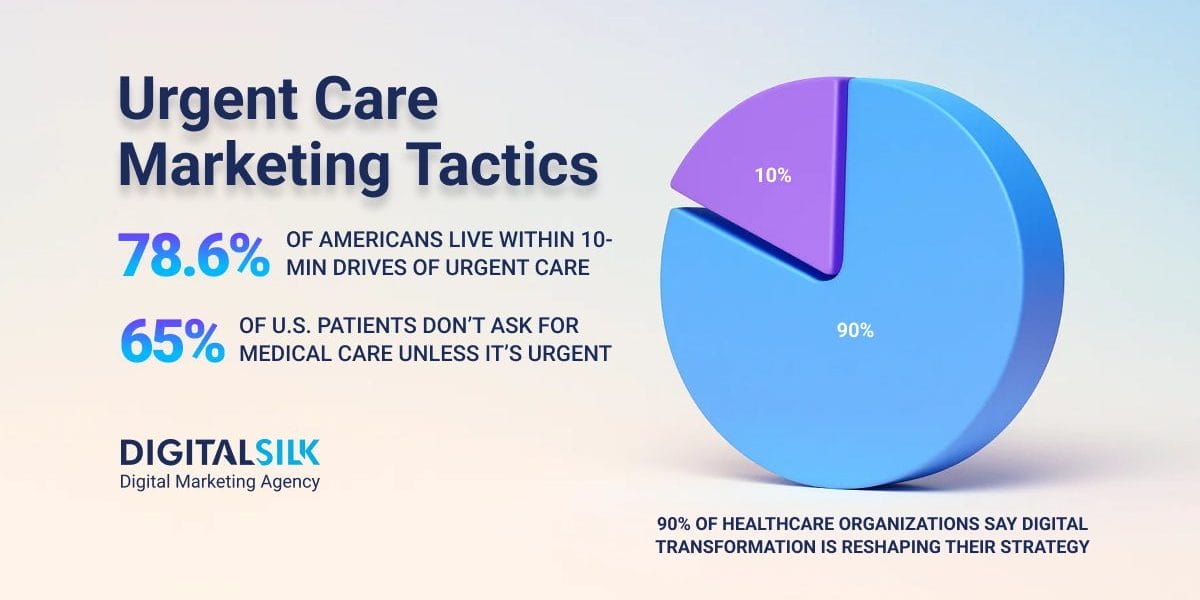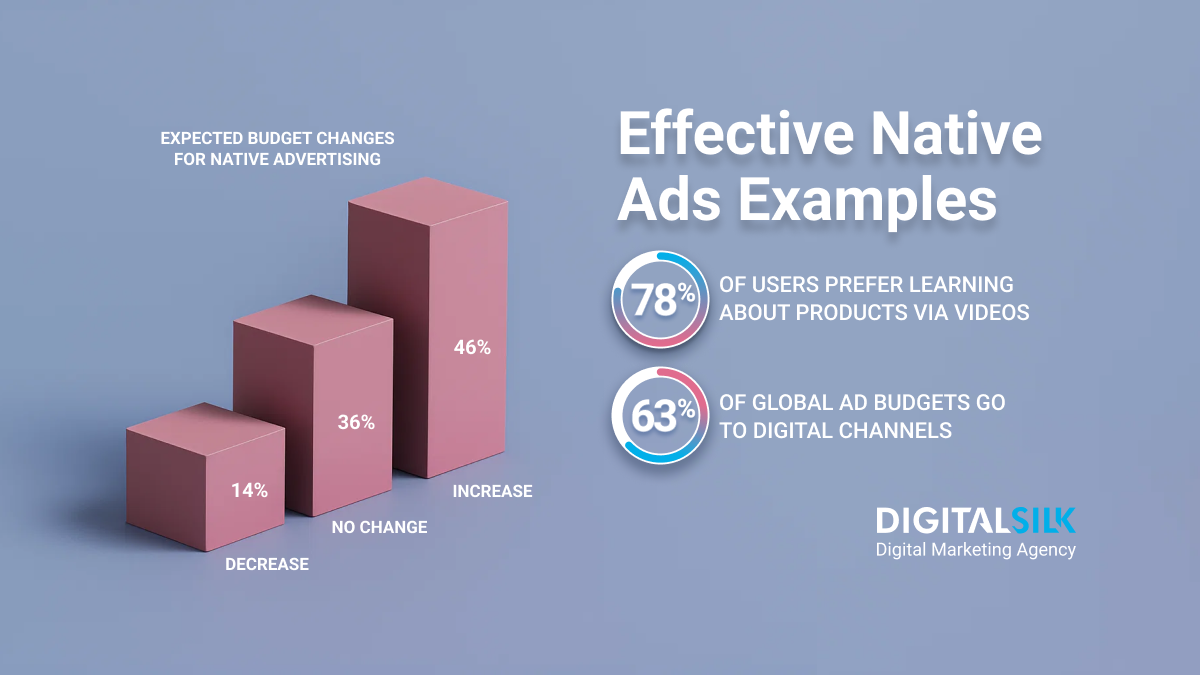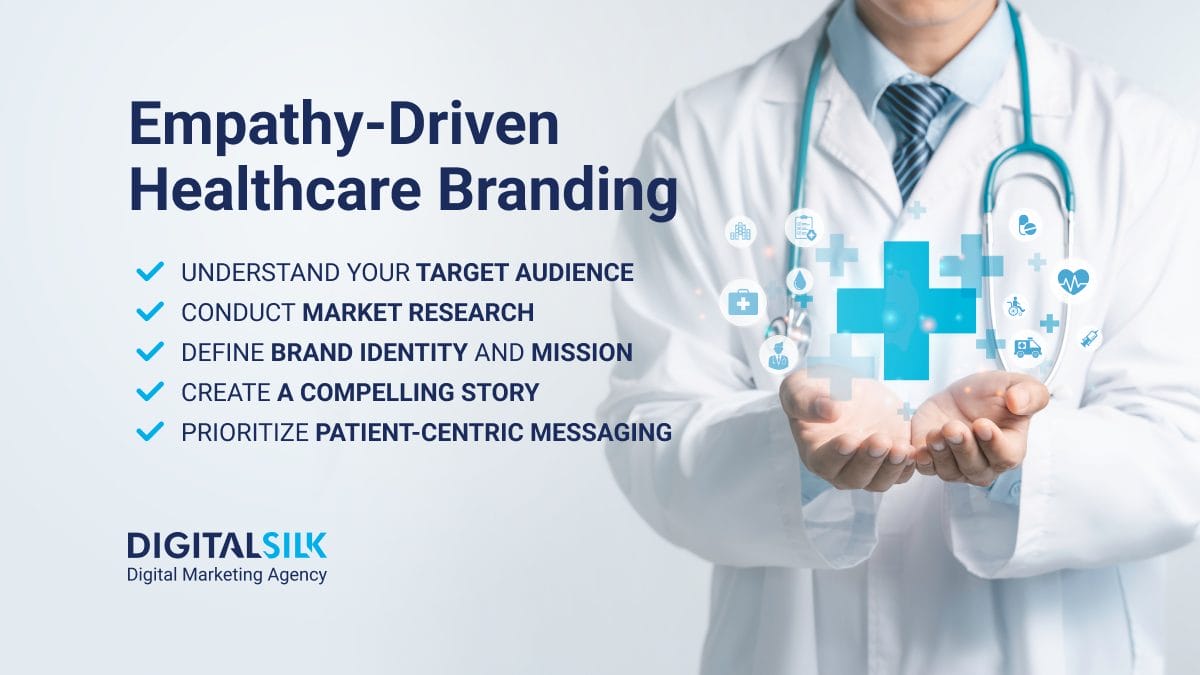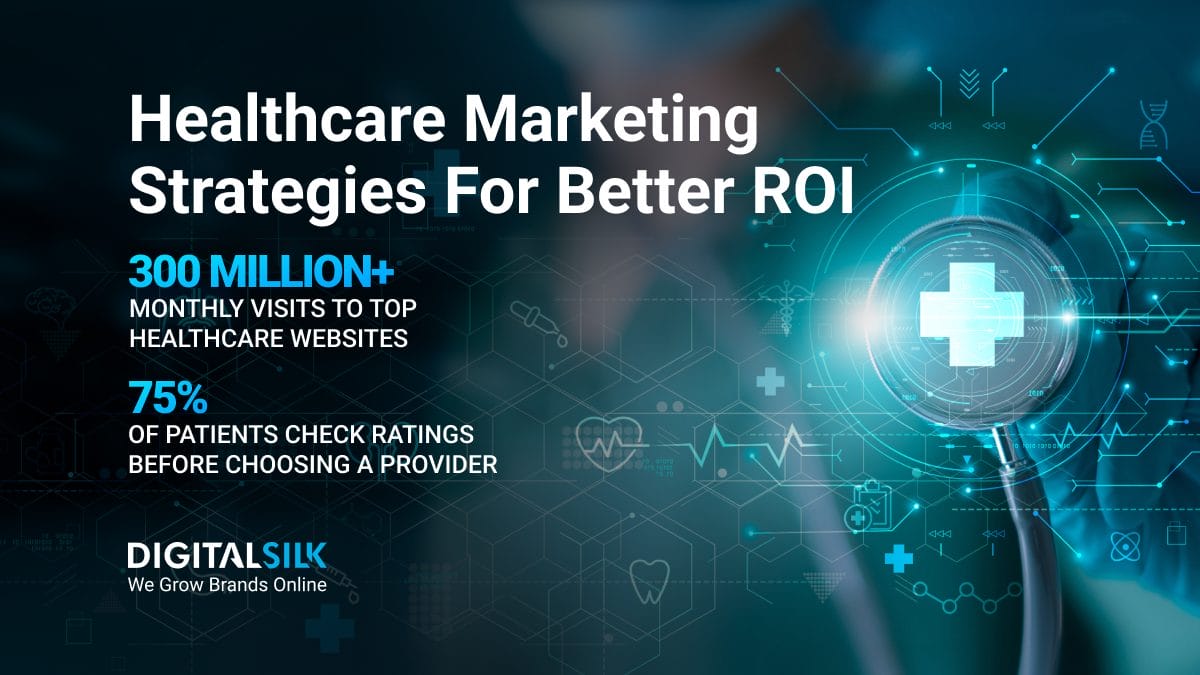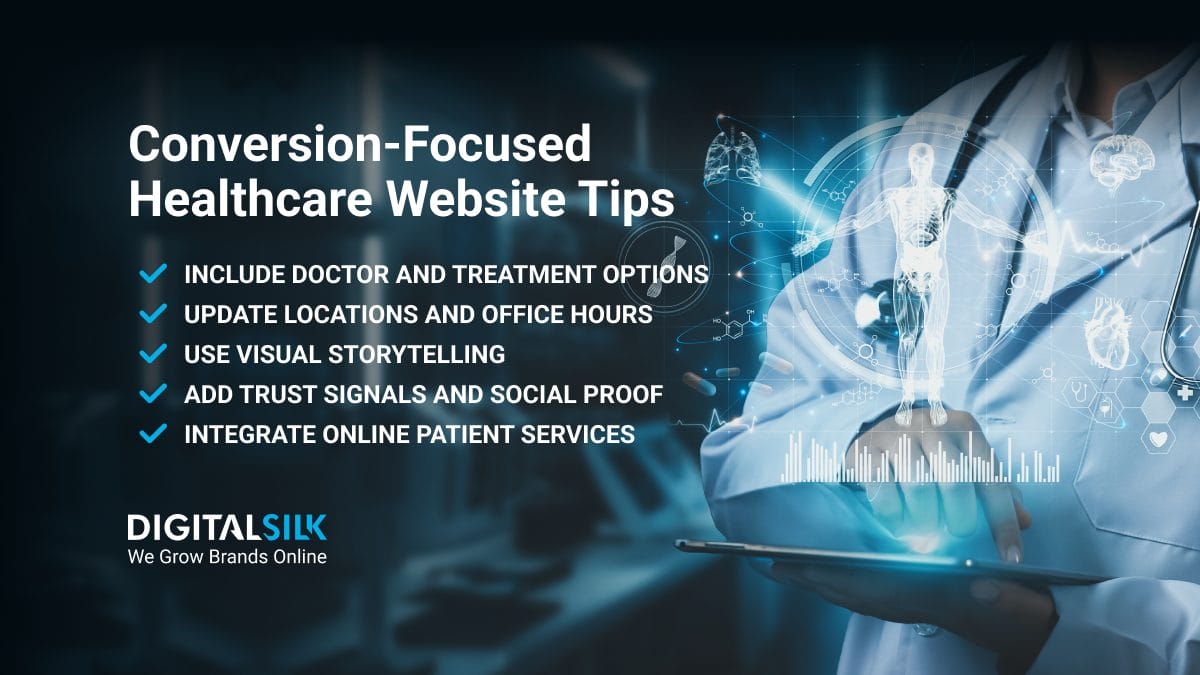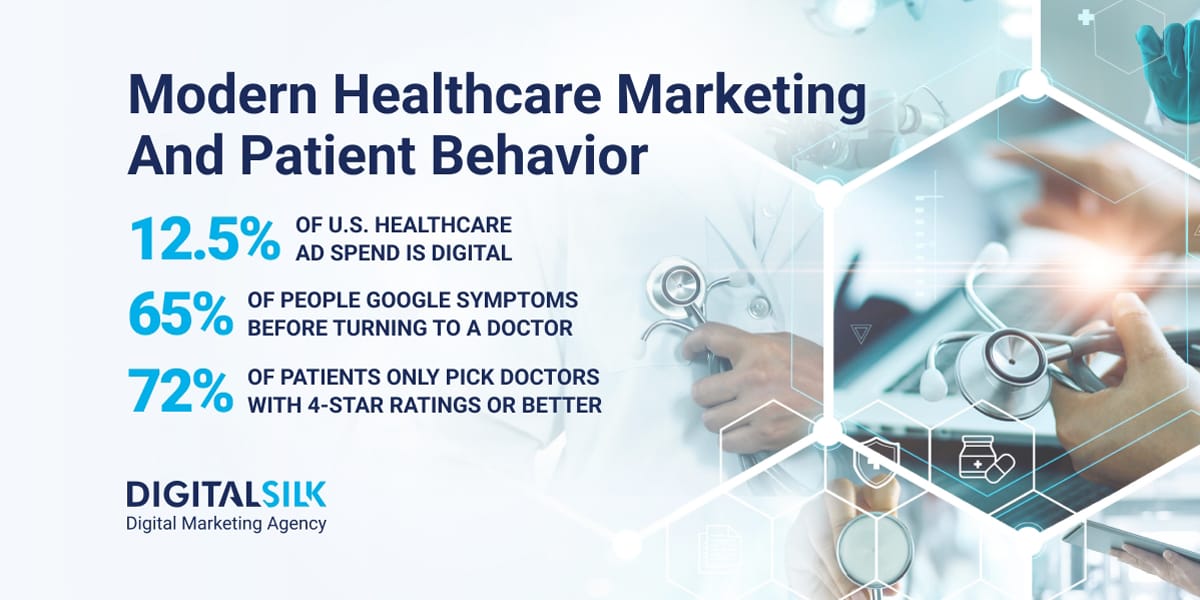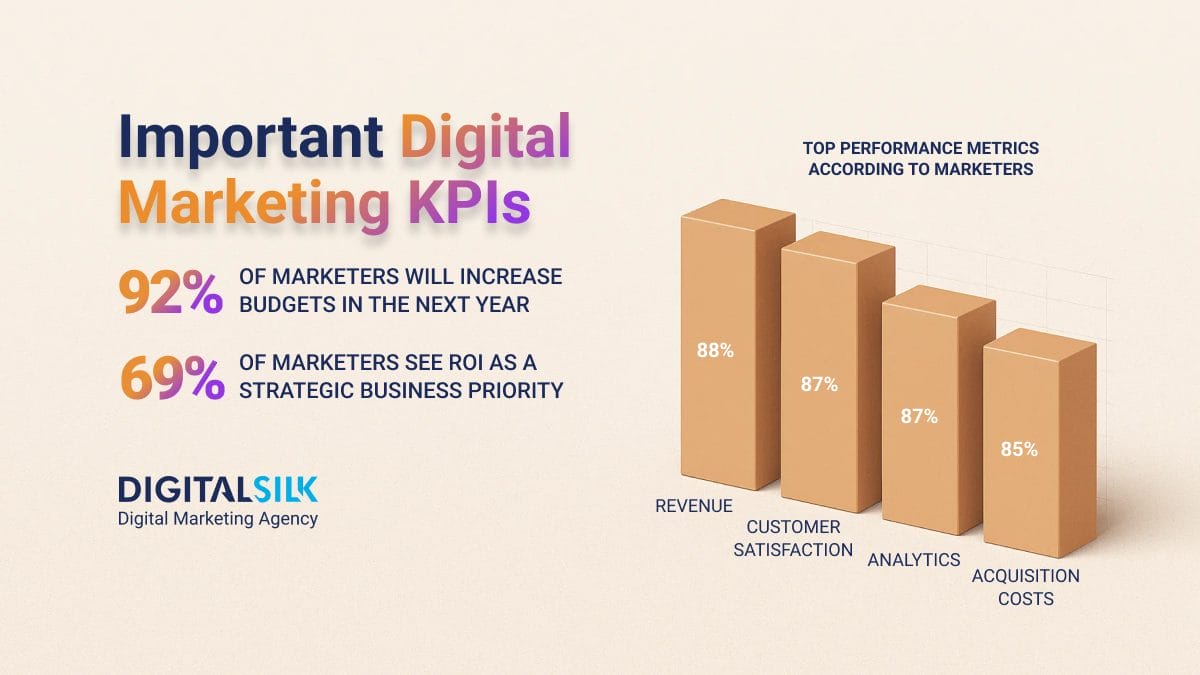Urgent Care Marketing Strategies: Key Highlights
-
Win the search moment: Most patients choose the first credible clinic they find online, so a complete and optimized Google Business Profile becomes the foundation of growth.
-
Blend visibility and intent: Combining local SEO with paid search ensures your clinic appears at the exact moment patients look for trusted, nearby care.
-
Design for reassurance: A fast, intuitive website that anticipates urgency and answers key questions turns online visitors into confident patients.
Imagine this: someone twists their ankle on a weekend, searches “urgent care near me” and picks the first credible, close clinic that looks trustworthy.
That moment, the few seconds between pain and action, defines modern urgent care marketing.
The U.S. urgent care centers market was valued at $34.34 billion in 2024 and is projected to reach $55.07 billion by 2030, growing at a CAGR of 8.60%.
As demand continues to climb, competition intensifies and patient expectations become more selective.
Providers that communicate trust, convenience and compassion online are the ones seeing growth, and not just more visits, but stronger patient loyalty.
This article explores nine effective urgent care marketing strategies designed to help your clinic attract, engage and retain patients, with data, examples and 2026-ready tactics you can apply immediately.
9 Urgent Care Marketing Strategies To Consider
More patients are turning to urgent care for their medical needs, with patient volume increasing by 60%.
This shift reflects how patients now prioritize speed, convenience and trusted care when making healthcare decisions, which creates both opportunities and challenges for providers.
The right urgent care marketing strategy can help your center connect with these evolving expectations and turn growing demand into sustained patient relationships.
1. Optimize Your Google Business Profile
Most patients who need urgent care start their search online, often choosing the clinic that appears closest and most credible.
With 78.6% of the U.S. population within a 10-minute drive of an urgent care center and 89.4% within 20 minutes, proximity matters, but visibility matters more.
A complete and regularly updated Google Business Profile anchors any marketing strategy for urgent care by ensuring patients can easily find, trust and contact your clinic when it matters most.
Here’s how to make your profile drive real patient growth:
- Keep information accurate and consistent: Verify your hours, contact details and services to ensure patients and search engines trust your listing.
- Post timely updates: Share service announcements, seasonal health tips or community involvement to keep your clinic active in local searches.
- Highlight what patients care about: List walk-in availability, current wait times and accepted insurance to make choosing your clinic easy.
- Request and respond to reviews: Encourage satisfied patients to share feedback and reply promptly to all reviews to show responsiveness and care.
- Add professional photos: Include welcoming images of your team, facility and treatment areas to build confidence before a visit.
For instance, RapidDoc Urgent Care’s Google Business Profile shows how a detailed and active listing can influence patient decisions.
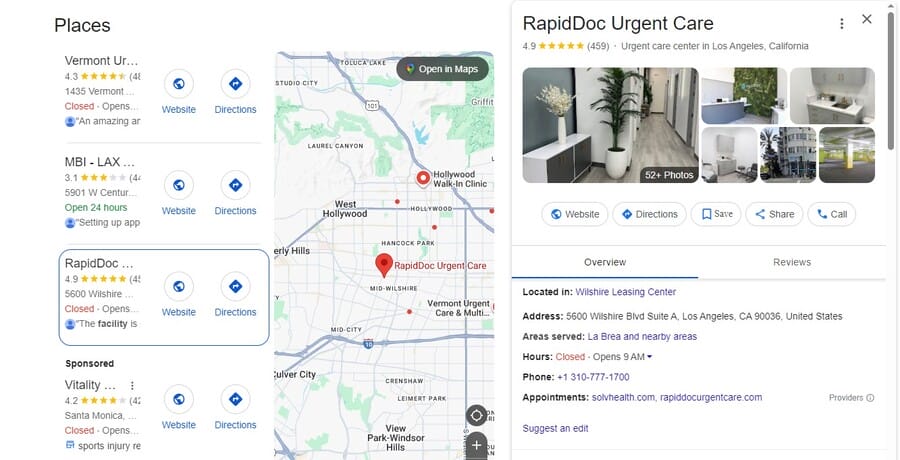
It includes accurate contact details, updated hours, professional photos and nearby area references that help patients find and trust the clinic quickly.
The consistent reviews and high rating further reinforce credibility, while the complete profile increases visibility in local search results at the exact moment patients are looking for care.
2. Invest in Both Paid And Organic Search
Paid and organic search account for 76% of all healthcare website traffic, with organic channels alone driving 41.9%.
For urgent care providers, this makes search visibility one of the most direct paths to patient growth.
SEO builds lasting visibility and trust, while pay-per-click (PPC) campaigns capture high-intent patients ready to act.
Use these urgent care digital marketing strategies to maximize SEO results:
- Prioritize local keywords: Use phrases such as “urgent care in [city]” or “walk-in clinic near [neighborhood]” to capture nearby searches.
- Use Google Trends for insight: Identify topics people are currently searching for and align your content with seasonal or regional health issues.
- Optimize for featured snippets: Format answers clearly to improve the chances of appearing in quick-answer boxes on Google.
- Tailor content by location: If you operate multiple centers, create dedicated pages that reflect local health concerns and services.
For instance, a search for “urgent care in Miami” highlights how top-performing clinics dominate organic results by focusing on clear, locally optimized content.
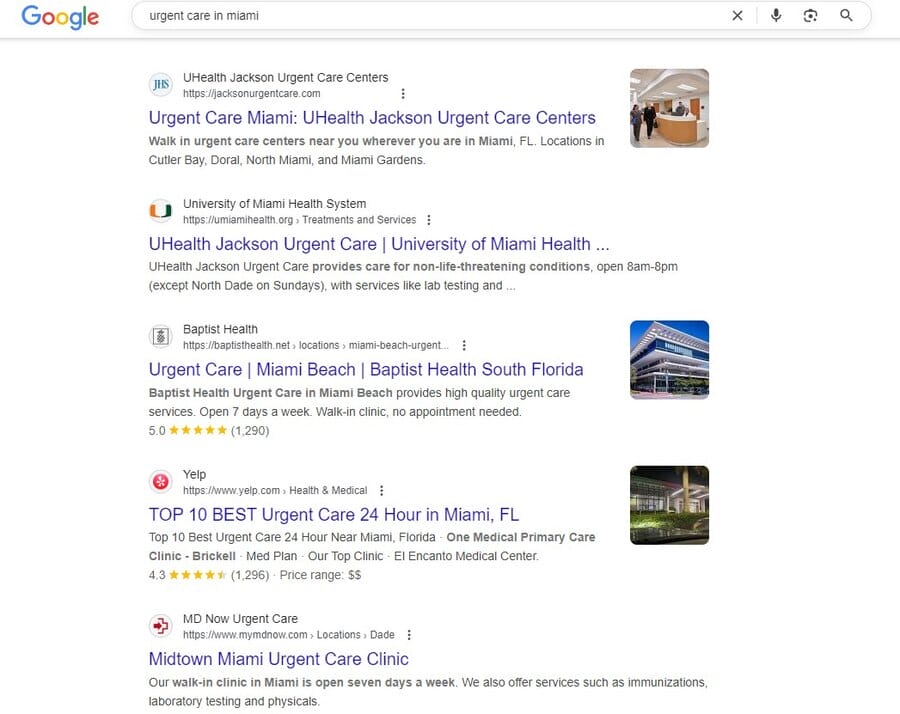
Listings from providers like UHealth Jackson and Baptist Health include city-specific keywords, service details and clear descriptions that match what patients are actively searching for.
Paid advertising complements this by driving immediate traffic from high-intent patients.
With an average cost per click of around $5 for the health and fitness category, PPC remains a cost-effective way to boost visibility for urgent care centers competing in busy local markets
You can use these steps to get more value from PPC:
- Target the right search terms: Focus on keywords such as “urgent care near me,” “same-day clinic,” or “minor injury treatment” that indicate immediate need.
- Refine geographic targeting: Concentrate your marketing budget within the zip codes or neighborhoods where your clinics operate.
- Apply geofencing tactics: Reach potential patients who enter specific areas like parks, gyms or schools with relevant service ads.
- Feature strong offers: Promote meaningful incentives such as low-cost physicals or special pricing for flu shots to encourage quick action.
- Track meaningful conversions: Measure calls, appointment requests and form submissions to understand which ads drive visits.
Let’s take the previous search for “urgent care in Miami” as an example.
The same query shows how paid ads appear above organic results, giving clinics like Miami Urgent Care and Sympti prime visibility when patients are ready to choose.
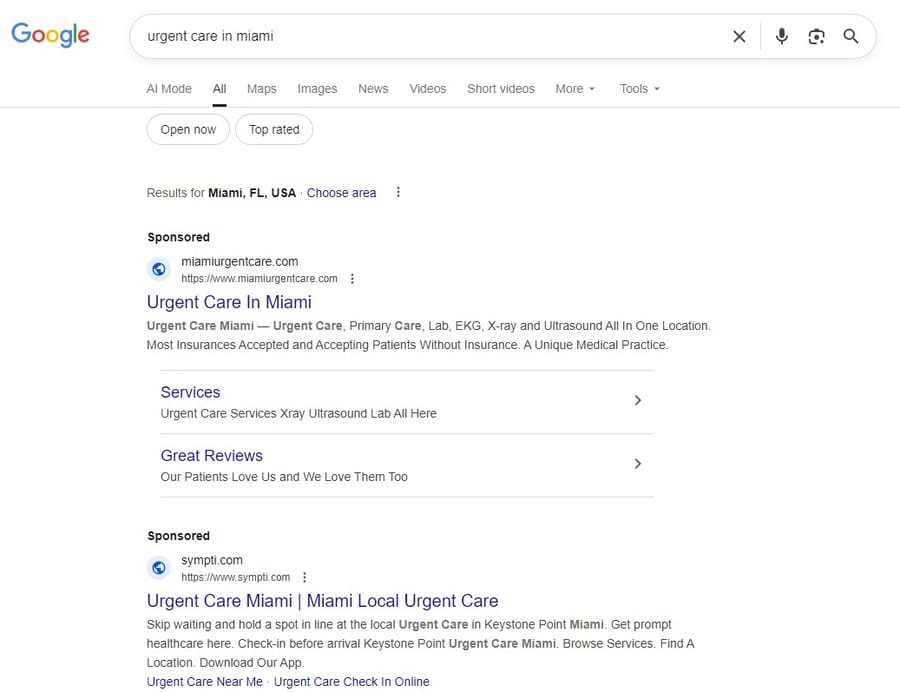
Their sponsored listings use clear headlines, local keywords and quick links to services and reviews, so users can move quickly from search to appointment.
This demonstrates how well-structured PPC campaigns can capture high-intent patients before they even scroll to organic results.
3. Build A User-Friendly Website
When someone searches for urgent care, they do more than just mere browsing, as they are looking for fast answers and immediate help.
Since patients are often under stress and short on time, your website should make it easy for them to find what they need and act quickly.
With 79% of healthcare providers planning to use their website, alongside SEO, as a key driver of new patients, your site’s design and usability are the key to effective marketing for urgent care.
A high-converting site that guides patients effortlessly from search to visit can turn a stressful situation into a smooth experience.
Here’s how you can improve the usability of your website:
- Prioritize speed and reliability: Optimize for quick load times on any device so patients can get to your information immediately.
- Make navigation effortless: Keep key details like services, hours, insurance and directions visible from the homepage.
- Offer easy scheduling or check-in: Allow patients to view wait times, reserve a spot or preregister to shorten their visit.
- Write content that answers urgent questions: Include short, clear explanations for common issues like flu symptoms or minor injuries to help patients make informed decisions.
- Enable live chat or messaging: Give patients a quick way to ask questions or confirm availability without waiting on hold.
For instance, MedRite Urgent Care’s website shows how a user-friendly, fast-loading and empathetic design can turn patient urgency into action.
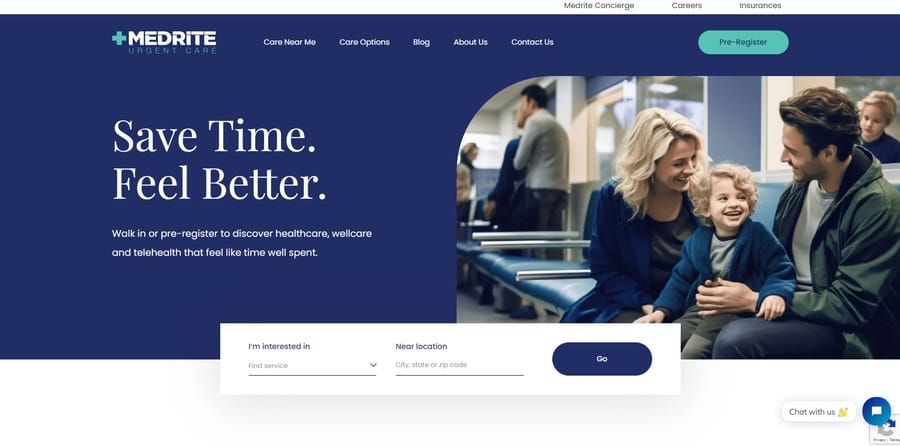
The homepage immediately reassures visitors with a simple message, visible pre-registration button and quick access to services and locations.
Features like online check-in, easy navigation and chat support reflect a deep understanding of what patients need when every minute matters.
4. Encourage Patient Reviews And Referrals
Most patients decide where to go for care the moment they need it and their choice is often guided by what others say about your clinic.
Over 70% of patients in the U.S. read online reviews when choosing a new doctor, making reputation a driving force behind patient decisions.
Encouraging authentic reviews and referrals is one of the most effective urgent care marketing ideas because it builds credibility through real experiences, not promotions.
To make reviews a meaningful part of your growth strategy, focus on creating a simple and genuine feedback loop:
- Ask after every visit: Send a short, friendly review request when the experience is still fresh in the patient’s mind.
- Make leaving reviews simple: Include direct links to Google or Yelp in follow-up messages to make the process effortless.
- Respond with care: Thank every reviewer and address concerns with professionalism to show that your team listens and acts.
- Share real experiences: Feature authentic reviews on your website and social channels to demonstrate the value of your care through patient voices.
Once you’ve established a consistent flow of feedback, take it a step further by turning positive experiences into referrals:
- Create a referral program that feels rewarding: Offer small but thoughtful incentives, such as discounted visits or local gift cards, for each referral.
- Promote referrals across patient touchpoints: Include referral reminders in follow-up emails, check-in kiosks and patient portals so the opportunity feels natural and easy.
- Recognize loyalty: Thank and reward repeat visitors and referring patients personally to strengthen long-term relationships.
5. Leverage Social Media Marketing
While patients won’t necessarily turn to social media in an emergency, it can build the awareness and familiarity that influence where they go when the need arises.
Social media accounts for 10.7% of healthcare marketing budgets in the U.S., ranking second only to professional meetings and conferences.
These platforms are a space to stay visible, share knowledge and create meaningful touchpoints long before a visit becomes necessary.
Data-driven marketing to urgent care patients on these platforms is about being present, relatable and useful in the moments that shape future decisions.
Below are some ways you can optimize your social media presence:
- Choose platforms with purpose: Use Facebook for timely updates and patient stories, Instagram for visuals that humanize your brand and TikTok for short, approachable health videos.
- Share relevant, real-time content: Post about seasonal services, weekend availability or common health concerns that match what your audience might be experiencing.
- Show the human side of your team: Highlight staff, community initiatives and behind-the-scenes moments to build trust and recognition.
- Use paid campaigns strategically: Run geo-targeted ads to reach people near your clinic or in areas with active, health-conscious communities.
- Engage consistently: Respond to questions, comments and feedback to reinforce that your clinic values connection and care at every touchpoint.
For instance, CityMD uses its social media channels to highlight the people behind its care, turning staff recognition into authentic storytelling.
In this post, the spotlight on a Physician Assistant during APP Week shares a personal reflection about connection and compassion, giving patients a glimpse into the clinic’s values.
By showcasing real team members and their motivations, CityMD humanizes its brand and reinforces the trust that drives patients to choose their centers when care can’t wait.
6. Use Email Marketing For Patient Retention
Email marketing gives urgent care centers a direct and personal way to stay connected with patients after their visit.
With an average open rate of 41% and a conversion rate of 2.6% in the healthcare industry, it remains one of the most reliable channels for meaningful engagement.
In urgent care advertising, email can help build familiarity, encourage repeat visits and remind patients that your clinic is available whenever care is needed.
The key is to make every message timely, useful and easy to act on:
- Share relevant updates: Send seasonal reminders about flu shots, school physicals or allergy treatments that matter to your community.
- Use appointment reminders wisely: Automate confirmations and follow-up messages to reduce missed visits and maintain continuity of care.
- Segment your patients: Create tailored messages for families, athletes or older adults so content feels personal and relevant.
- Provide helpful information: Include quick tips or short health insights that patients can apply right away.
- Maintain HIPAA compliance: Protect patient privacy by keeping communications secure and avoiding sensitive details in messages.
7. Engage In Your Local Community
As of 2025, there are 15,032 open urgent care centers across the U.S., each competing for the attention of the same local patients.
What makes a clinic memorable isn’t the size of its marketing budget but the depth of its presence in the community.
When people see your team volunteering, sponsoring events or supporting local causes, they begin to view your clinic as part of the neighborhood rather than just another healthcare option.
Within an impactful urgent care digital marketing strategy, local engagement builds familiarity that advertising alone can’t achieve.
There are many ways to make your clinic a visible and trusted part of everyday community life:
- Participate in local events: Support school programs, youth sports or community health fairs to create positive, lasting impressions.
- Host approachable health events: Offer free flu shot days, sports physicals or health screenings that bring your staff face-to-face with residents.
- Collaborate with nearby organizations: Partner with schools, fitness centers and employers to provide workshops or occupational health programs.
- Support meaningful causes: Contribute to fundraisers, local drives or charity initiatives that reflect shared community values.
- Welcome people in: Organize open houses or facility tours so residents can meet your staff and experience your care before they ever need it.
For instance, Gateway Family & Urgent Care’s Concert for a Cause is a standout example of community involvement done right.
The event turns their parking lot into a lively gathering place with music, raffles, food trucks and local vendors, all in support of a charitable cause.
By connecting with people in a relaxed, enjoyable setting, the clinic builds genuine relationships and reinforces its role as a trusted, caring part of the community.
8. Create Educational And Patient-First Content
65% of Americans admit they don’t seek medical care until a health issue feels urgent, which means their first step is often searching online for answers.
That moment presents an opportunity for your clinic to be the trusted source they find.
Educational, patient-first content is a key part of an urgent care strategy because it connects information with reassurance, guiding people from uncertainty to action.
When your clinic becomes the one that helps them understand their situation, you earn trust long before they walk through your doors.
The most impactful content informs, comforts and builds confidence in your care by:
- Addressing real concerns: Write blogs, FAQs and short guides that explain when to visit urgent care, what to expect during a visit and how to handle common conditions or injuries.
- Using video to educate: Share short, approachable videos that demonstrate treatments, showcase your facility or introduce your medical team in a friendly, relatable way.
- Covering timely topics: Publish seasonal content about flu prevention, allergy care or sports injuries to stay relevant throughout the year.
- Keeping information simple and clear: Use straightforward language that helps patients understand their options without medical jargon.
- Sharing authentic stories: Highlight staff experiences, community involvement and positive patient outcomes that reflect your clinic’s compassion and credibility.
For example, MD Now Urgent Care uses its blog to educate patients on everyday health concerns through clear, accessible content.
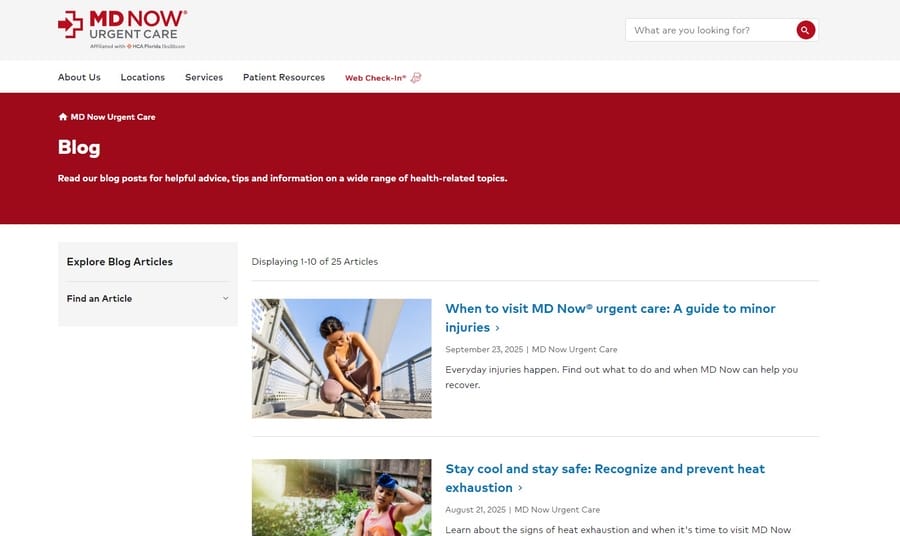
Articles like “When to visit MD Now Urgent Care: A guide to minor injuries” and “Recognize and prevent heat exhaustion” help readers understand when to seek care and how to stay safe.
This approach reflects a patient-first mindset, turning simple health advice into a trust-building tool that guides people from awareness to action.
9. Track And Adjust Your Strategy
An effective marketing strategy depends on understanding how patients engage with your clinic and what motivates them to act.
Data offers that visibility, helping you refine your approach and focus on what drives measurable results.
The most successful urgent care marketing tactics come from observing patterns, testing new ideas and making continuous improvements over time.
Use these strategies to monitor your digital marketing performance:
- Use reliable analytics tools: Platforms like Google Analytics and Search Console reveal how patients discover your website and which pages lead to conversions.
- Measure what matters: Track KPIs like cost per lead, patient acquisition rates and appointment requests to understand where your marketing delivers real value.
- Experiment with intention: A/B test different headlines, visuals and layouts to find what resonates most with your audience.
- Monitor the patient journey: Identify points where visitors drop off in scheduling or form submissions and make the experience smoother.
- Review results consistently: Schedule regular check-ins to evaluate progress, adjust spending and respond to shifting patient behavior.
Why A Digital Marketing Strategy Matters For Urgent Care
Patients rarely plan their visit to urgent care, which means the choice of where they go often comes down to who they already know and trust.
Applying well-defined urgent care marketing tips helps you reach patients at the right moments, use data effectively and grow in a market where convenience and credibility drive decisions.
Here are a few reasons a defined strategy makes such a difference:
- Adapt to digital transformation: With 90% of healthcare organizations saying that accelerated digital transformation is reshaping their strategies, urgent care centers need to connect with patients through faster, more personalized digital experiences.
- Compete in an expanding digital market: Healthcare and pharmaceutical digital ad spend is expected to hit $24.71 billion by 2026, so being strategic about where and how you invest is key to staying visible.
- Design for patient convenience: Today’s patients expect quick scheduling, transparent information and follow-up communication that feels personal and dependable.
- Prioritize retention over constant acquisition: Retaining patients through consistent outreach and reliable service costs less and builds a more stable foundation for long-term growth.
- Educate patients on their options: Since 1 in 5 adults visits an emergency department at least once, helping them understand when urgent care is the better choice can capture a significant share of potential visits.
- Differentiate from telehealth and hospital networks: Competing against larger systems requires focusing on accessibility, local reputation and the personal touch that keeps your clinic top of mind.
Emerging Urgent Care Marketing Trends For 2026 & Beyond
Patient expectations are shifting toward on-demand, digital-first experiences.
To stay competitive, urgent care operators are leaning into smarter, data-driven marketing that meets patients where they are, including online, local and mobile:
- AI-powered patient acquisition: Predictive algorithms will increasingly identify high-propensity patients before peak seasons and allow clinics to proactively target those most likely to need care.
- Voice search optimization: More patients are turning to voice assistants like Siri, Alexa, and Google Assistant to “find urgent care near me”.
- First-party data and privacy readiness: With stricter data regulations ahead, clinics are shifting toward consent-based, first-party data strategies that build trust while improving targeting.
- Telehealth and physical hybrid marketing: Combining telehealth options into local campaigns strengthens convenience messaging and positions clinics as full-spectrum care providers.
- Community-based SEO automation: AI-driven local campaigns will dynamically update keywords, listings and content by zip code to keep visibility high across service areas.
What this means: The future of urgent care marketing combines automation, empathy and accessibility. Technology drives reach, but human connection builds loyalty.
Common Mistakes In Urgent Care Marketing
Many urgent care centers limit their growth by overlooking simple, fixable issues.
Recognizing these gaps early can make your urgent care business marketing more consistent and effective.
Here are some of the most common mistakes to avoid:
- Relying only on word-of-mouth: Referrals are valuable, but depending on them alone limits patient reach and long-term growth. Combine community reputation with digital marketing to stay visible.
- Ignoring mobile optimization: Most patients search for care on their phones, so a slow or hard-to-navigate website can quickly drive them away.
- Neglecting business listings: Unclaimed or outdated listings on Google, Yelp or Apple Maps lead to confusion about hours, contact details and directions.
- Failing to follow up after visits: Skipping post-visit communication wastes opportunities to gather feedback, build loyalty and encourage repeat visits.
Create An Urgent Care Marketing Strategy With Digital Silk
A successful urgent care marketing strategy isn’t built on one channel or campaign, but on how each touchpoint works together to inform, reassure and connect with patients when they need care most.
The clinics that grow are the ones that communicate clearly, invest in trust and stay adaptable in a changing healthcare environment.
Digital Silk offers marketing services for urgent care providers that combine data-driven insight, creative strategy and patient-focused storytelling to help you attract more patients, strengthen loyalty and achieve measurable growth.
As a professional digital marketing agency, our services include:
- Digital marketing for healthcare
- Premium digital marketing services
- SEO services
- PPC management
- Social media marketing
- Branding services for healthcare
- Healthcare website design
Contact our team, call us at (800) 206-9413 or fill in the Request a Quote form below to schedule a consultation.
"*" indicates required fields


